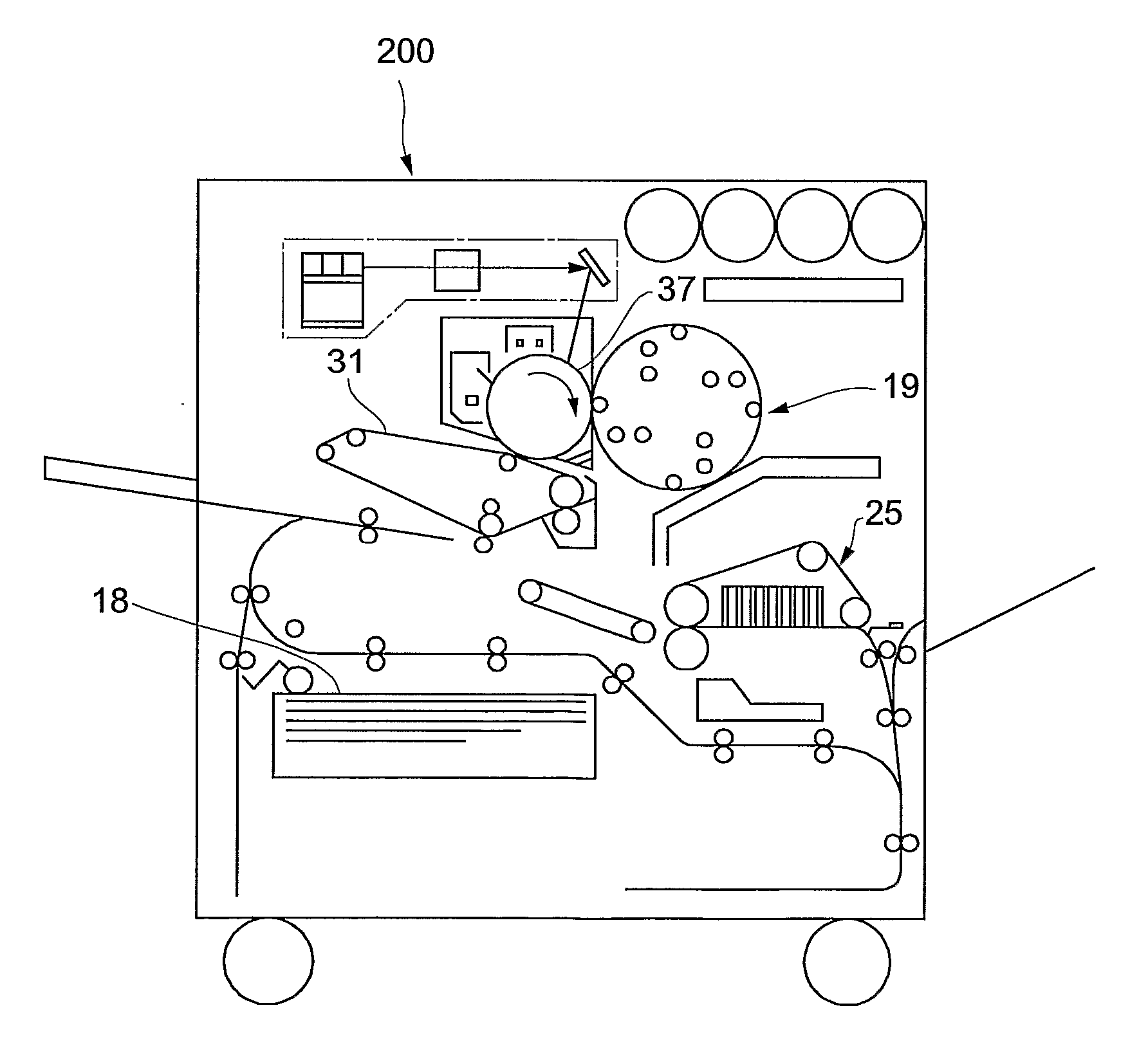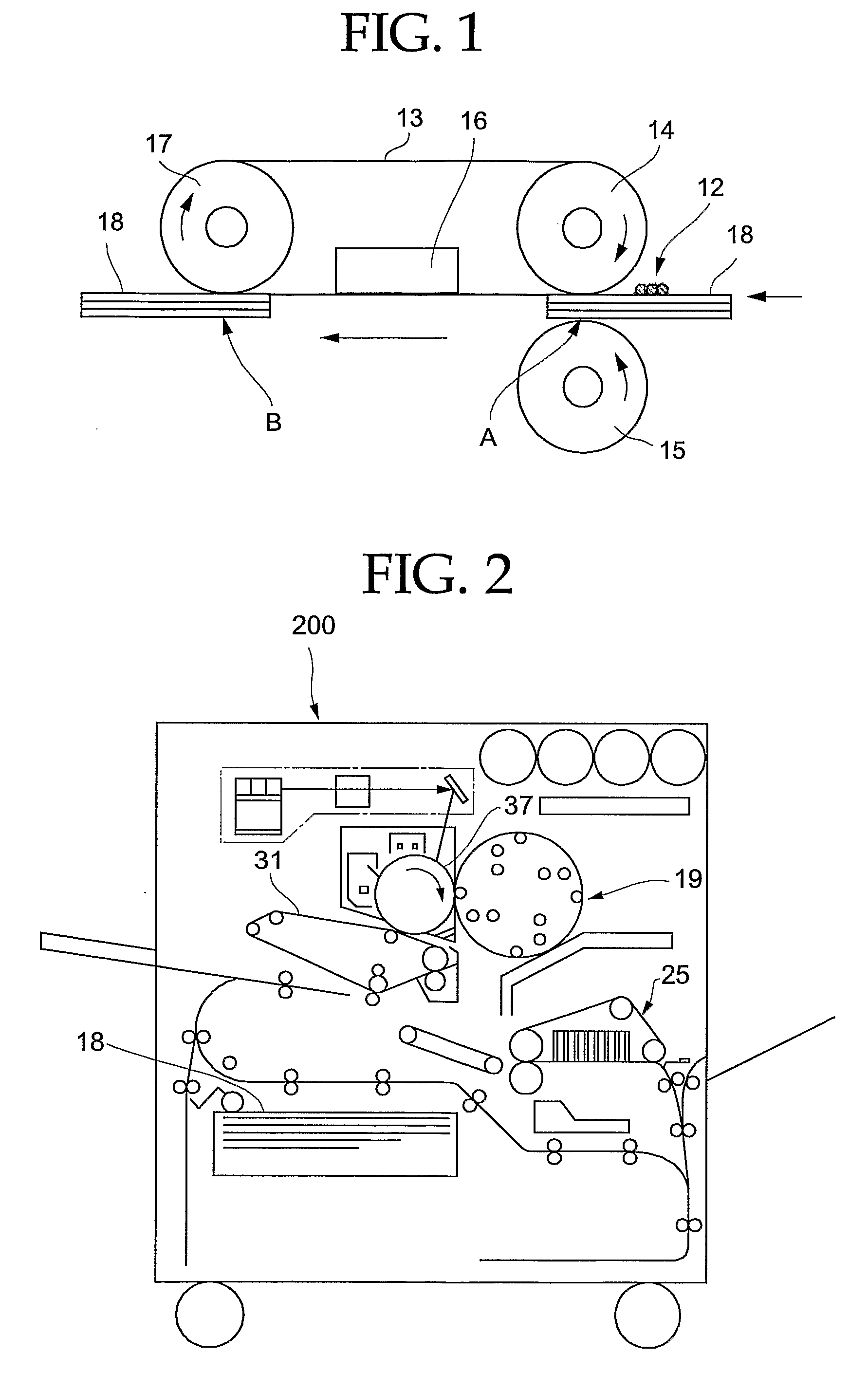Image-Receiving Sheet and Manufacturing Method Thereof, and Image-Forming Process and Image-Forming System for Electrophotography
a technology of image-receiving sheet and manufacturing method, which is applied in the direction of electrographic process, non-fibrous pulp addition, instruments, etc., can solve the problems of filter blockage, achieve excellent adhesion resistance, excellent adhesion resistance, and high image quality
- Summary
- Abstract
- Description
- Claims
- Application Information
AI Technical Summary
Benefits of technology
Problems solved by technology
Method used
Image
Examples
example 1
Production of Image-Receiving Sheet for Electrophotography
—Preparing of Raw Paper—
[0340] A pulp slurry was prepared by mixing 25% by mass of a pulp material obtained by beating LBKP (broad-leaf kraft pulp, bleaching pulp) made from acacia to 30 ml of Canadian Standard Freeness using a disk refiner with 75% by mass of a pulp material obtained by beating LBKP (broad-leaf kraft pulp, bleaching pulp) made from aspen to 300 ml of Canadian Standard Freeness using a disk refiner, relative to 100% by mass of the pulp slurry. The prepared pulp slurry was mixed with 1.3% by mass of a cationic starch (manufactured and sold by Nihon N.S.C. Company; trade name: CATO 304 L), 0.145% by mass of an anionic polyacrilamide (manufactured and sold by Seiko P.M.C. Corporation; trade name: Polyacron ST-13), 0.285% by mass of an alkyl ketene dimmer (manufactured and sold by Arakawa Chemical Industries, Ltd.; trade name: Sizepine K), 0.32% by mass of polyamidepolyamineepichlorohydrin (manufactured and sold...
example 3
[0365] In substantially the same manner as in Example 1, except that the aqueous dispersion of a polyester resin as a self-dispersible water-dispersible polymer in Example 1 was changed to a self-dispersible water-dispersible polyester resin emulsion (manufactured and sold by Unitika Ltd.; trade name: Elitel KZA-1449; having a solid content of 35% by mass, a glass transition temperature (Tg) of 46° C., a number average molecular weight of 6,500, a molecular-weight distribution of 3.2, a volume average diameter of 43 nm and a flow beginning temperature of 100.4° C.), the toner image-receiving sheet for the electrophtography of Example 3 was produced and in substantially the same manner as in Example 1, in the produced toner image-receiving sheet, the image was formed.
example 4
[0366] In substantially the same manner as in Example 1, except that the aqueous dispersion of a polyester resin as a self-dispersible water-dispersible polymer in Example 1 was changed to a self-dispersible water-dispersible polyester resin emulsion (having a solid content of 35% by mass, an acid component of terephthalic acid and isophthalic acid, an alcohol component of ethylene glycol, neopentyl glycol and an ethylene oxide adduct of a bisphenol A, a counter cathion of NH4+ ion, a glass transition temperature (Tg) of 72° C., a volume average particle diameter of 135 nm and a number average molecular weight of 6,500), the toner image-receiving sheet for the electrophtography of Example 4 was produced and in substantially the same manner as in Example 1, in the produced toner image-receiving sheet, the image was formed.
[0367] With respect to the obtained toner image-receiving sheets for the electrophtography of Examples 1 to 4 and Comparative Examples 1 to 5 respectively, a parti...
PUM
| Property | Measurement | Unit |
|---|---|---|
| volume average particle diameter | aaaaa | aaaaa |
| Tg | aaaaa | aaaaa |
| volume average particle diameter | aaaaa | aaaaa |
Abstract
Description
Claims
Application Information
 Login to View More
Login to View More - R&D
- Intellectual Property
- Life Sciences
- Materials
- Tech Scout
- Unparalleled Data Quality
- Higher Quality Content
- 60% Fewer Hallucinations
Browse by: Latest US Patents, China's latest patents, Technical Efficacy Thesaurus, Application Domain, Technology Topic, Popular Technical Reports.
© 2025 PatSnap. All rights reserved.Legal|Privacy policy|Modern Slavery Act Transparency Statement|Sitemap|About US| Contact US: help@patsnap.com



